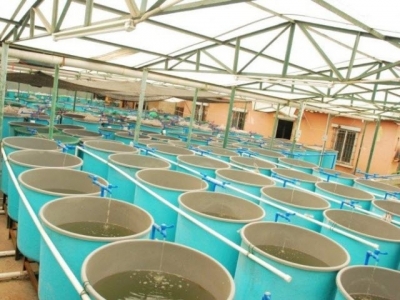Dietary curcumin may boost fish survival, performance in disease challenge

Farmed fish facing a bacterial challenge may see a survival and performance support from feed supplemented with curcumin, say researchers.'
“Our hypothesis is that antioxidant and immunomodulatory effects of curcumin can enhance the resistance of silver catfish to S. agalactiae infection,” the researchers said. “The aim of this study was to evaluate whether fish fed with a diet containing 150 mg curcumin/kg feed is able to enhance the resistance of silver catfish to S. agalactiae infection.”
The researchers found that the addition of curcumin to catfish feed was able to improve performance results for fish facing a bacterial infection. The feed additive also appeared to prevent clinical disease signs, including erratic swimming, corneal opacity, appetite loss and skin lesions, from appearing in infected fish.
“We concluded that dietary supplement of curcumin at 150 mg/kg feed for 14 days exerts potent bacterial action in fish experimentally infected with S. agalactiae,” they said. “In summary, curcumin can be a promising dietary supplement for improving disease resistance.”
Why dietary curcumin?
In aquaculture, producers seek the most efficient ways to raise the largest number of fish, said the researchers. However, disease can be a problem to the development of aquaculture and to producers’ economic returns.
Streptococcus agalactiae, or group B Streptococcus (GSB), is a bacterium that has the ability to infect multiple fish and has been linked with outbreaks of septicemia and meningoencephalitis in fish farms globally, they said. “In fish, this disease is characterized by loss of appetite, exophthalmia, eye hemorrhage, corneal opacity, abnormal behavioral and severe inflammation, causing high mortality and severe economic losses in several freshwater species such as Nile tilapia (Oreochromis niloticus), rohu carp (Labeo rohita) and the silver catfish (Rhamdia quelen),” they added.
Efforts to control the infection caused by the bacteria include the use of antimicrobial products and vaccinations, they said. However, use of antibiotics can have a negative effect on the environment and on human health.
Alternative methods of disease prevention are of interest to aquaculture producers, they said. Some of these include use of feed additives like curcumin.
Curcumin is a polyphenolic compound derived from the dried form of Curcuma longa and is considered to have several biological properties including as a hepato-protector, anti-parasitic and being immunomodulatory and bactericidal when given to fish, said the researchers. There is some evidence that the feed additive could improve immune system response to bacterial infection.
“A diet containing curcumin increased the resistance of Nile tilapia experimentally infected with Aeromonas hydrophila due to the improvement of immune and antioxidant status,” they said.
Feeding trial details
In the feeding trial, 40 juvenile fish were given one of two diets for a period of 14 days, said the researchers. However, all fish were observed through day 30.
Fish groups in the trial included a negative control that was not infected and not given supplemented feed (A), a group that was given supplemented feed but was not infected (B), a positive control group that was infected and given non-supplemented feed (C) and a group that was infected and given supplemented feed, they said.
To generate the experimental feed, the control diet was mixed with 150mg/kg of commercially prepared curcumin powder, they said.
Fish were checked for mortality, longevity, therapeutic efficacy and for the presence of lesions through day 30 and then collected, they said.
Results
A difference was seen among the groups of fish getting the supplemented and non-supplemented diets, said the researchers.
“Our results demonstrated that curcumin dietary supplement exerts potent bactericidal action against S. agalactiae, presenting 100% of therapeutic efficacy when compared to infected and non-supplemented animals,” they said. “Also, the treatment prevented the occurrence of clinical signs of disease, as erratic swimming, corneal opacity, skin lesions in the fin and tail, and loss of appetite.”
The infected fish not getting the supplemented diet presented disease symptoms including erratic swimming, corneal opacity, loss of appetite and skin lesions, they said. Those getting the curcumin-inclusive feed did not demonstrate clinical symptoms and were similar to uninfected fish.
No uninfected fish and no infected, supplemented fish died during the experimental period, they said. The infected, non-supplemented fish all died during the trial period.
“A significant increase on animal longevity was observed in the infected and curcumin-supplemented group, that presented 100% of therapeutic efficacy, compared to positive control,” they said.
Source: Microbial Pathogenesis
Authors: Matheus Baldissera, Carine Souza, Carla Zeppenfeld, Sharine Descovi, Vanessa Machado, Roberto Santos, Bernardo Baldisserotto
Có thể bạn quan tâm
Phần mềm

Phối trộn thức ăn chăn nuôi

Pha dung dịch thủy canh

Định mức cho tôm ăn

Phối trộn phân bón NPK

Xác định tỷ lệ tôm sống

Chuyển đổi đơn vị phân bón

Xác định công suất sục khí

Chuyển đổi đơn vị tôm

Tính diện tích nhà kính

Tính thể tích ao hồ



 Biofloc technology holds potential for carnivorous fish species
Biofloc technology holds potential for carnivorous fish species  Mercury feed contamination may affect feed intake in…
Mercury feed contamination may affect feed intake in…